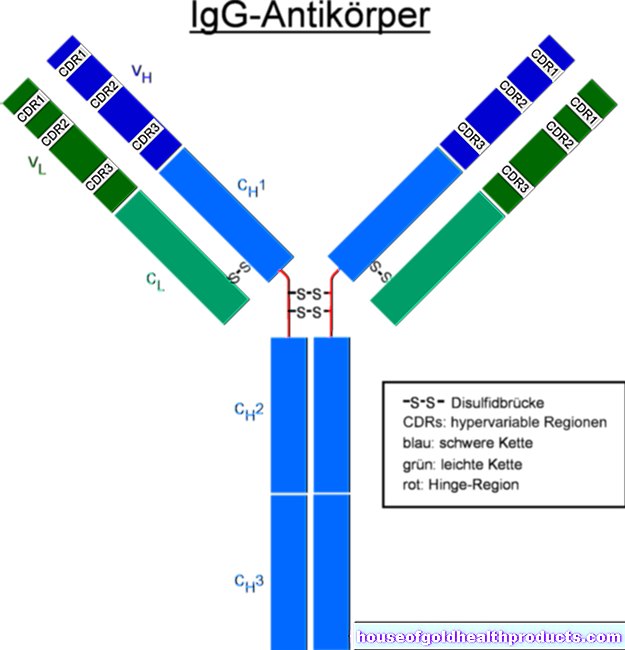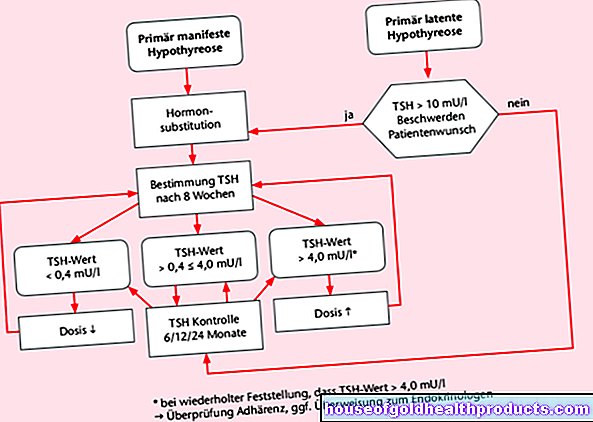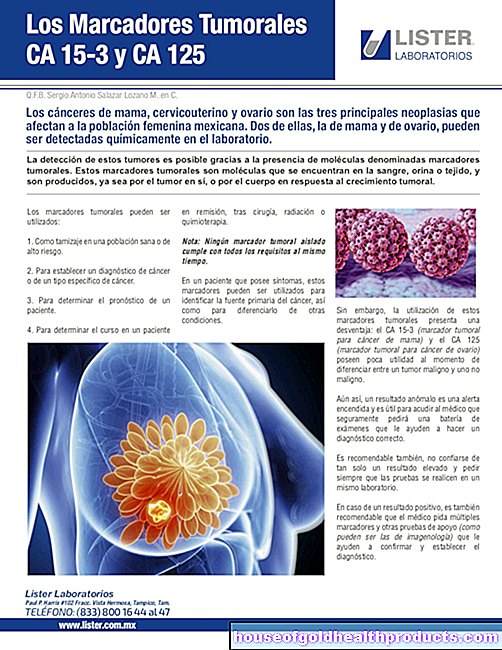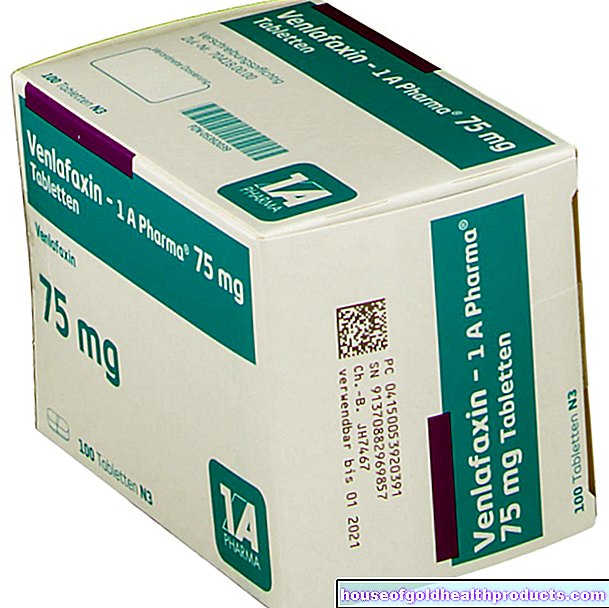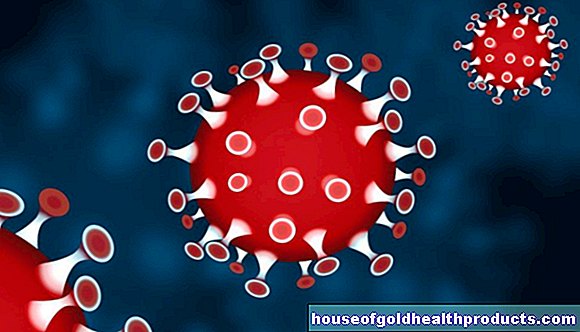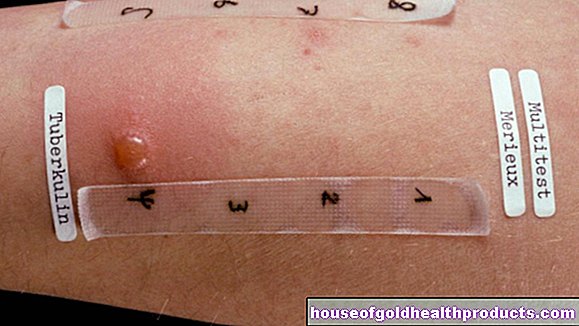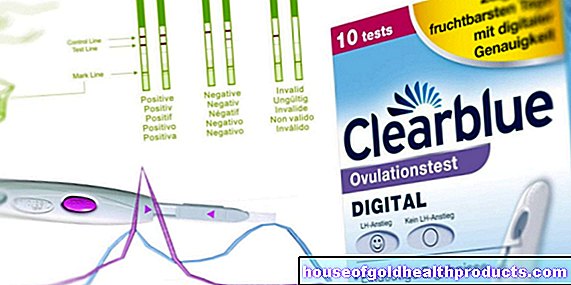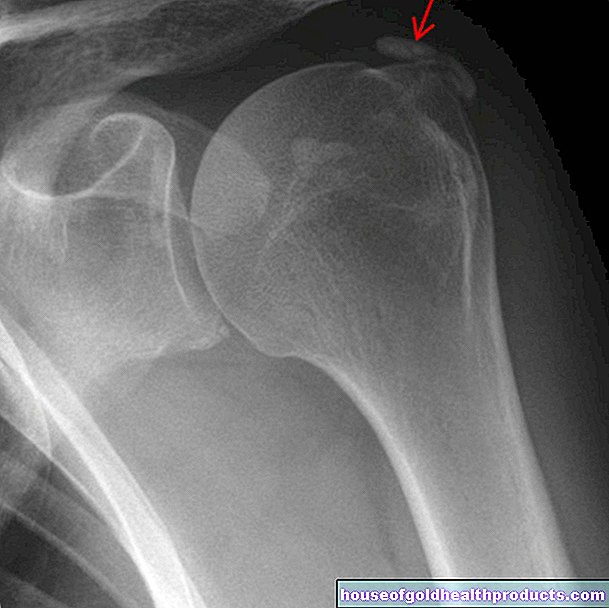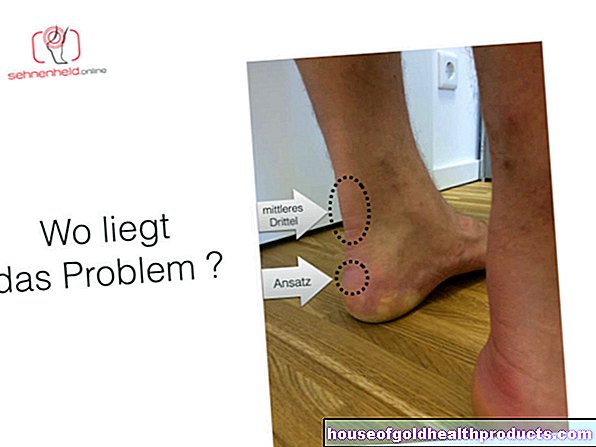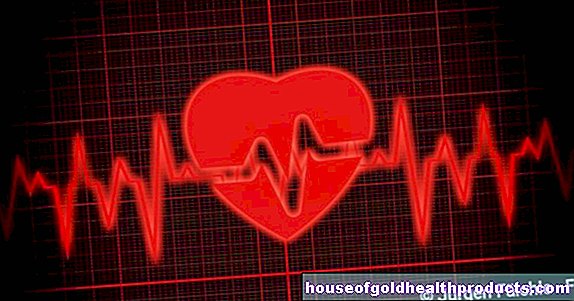Alpha-1 antitrypsin deficiency
Sophie Matzik is a freelance writer for the medical team.
More about the experts All content is checked by medical journalists.Alpha-1 antitrypsin deficiency (Laurell-Eriksson syndrome) is a hereditary disease in which the body lacks the enzyme alpha-1 antitrypsin. This can cause tissue damage to the lungs and liver. In extreme cases, alpha-1 antitrypsin deficiency can be life-threatening. Read here what the typical symptoms of alpha-1 antitrypsin deficiency are and how you can live with the disease in the long term.
ICD codes for this disease: ICD codes are internationally recognized codes for medical diagnoses. They can be found, for example, in doctor's letters or on certificates of incapacity for work. E88
Alpha-1 Antitrypsin Deficiency: Description
Alpha-1 antitrypsin deficiency (also Laurell-Eriksson syndrome or AAT deficit) is a hereditary disease. Incorrect genetic information means that the enzyme alpha-1-antitrypsin (AAT) is not produced correctly, is reduced or is no longer produced at all.
In healthy people, alpha-1 antitrypsin is produced in the liver but acts throughout the body as part of the immune response. The immune system in the lungs plays an extremely important role as it is in direct contact with the outside world. Many substances get into the lungs with every breath, including potential pathogens.
In order to kill these off or to transport them out again, the lungs have various defense mechanisms. These include, for example, neutrophil granulocytes (a subtype of white blood cells. They destroy pathogens by releasing an enzyme called neutrophil elastase, for example. This, however, is not specifically directed against the pathogen and can also destroy lung tissue.
To prevent this, the body produces alpha-1 antitrypsin, which inactivates neutrophil elastase and thus protects the lung tissue. If not enough alpha-1-antitrypsin is produced, neutrophil elastase can gradually destroy the body's own lung tissue, resulting in secondary diseases such as pulmonary emphysema.
Tissue damage caused by AAT deficiency is first noticeable in the lungs. Later the liver and skin are also affected.
The most common secondary disease in an alpha-1-antitrypsin deficiency is chronic obstructive pulmonary disease (COPD) with overinflation of the lungs and the development of pulmonary emphysema. This makes breathing much more difficult for those affected. Pulmonary emphysema can be life-threatening as less and less tissue is available for gas exchange or breathing.
A characteristic of alpha-1-antitrypsin deficiency is that pulmonary emphysema usually occurs between the ages of 30 and 40, and thus much earlier than with COPD caused by smoking. Possible liver damage caused by an alpha-1 antitrypsin deficiency, on the other hand, is usually already noticeable in childhood and adolescence.
Alpha-1 antitrypsin deficiency: prevalence
Alpha-1 antitrypsin deficiency is rare. The proportion of sick people in Europe in whom both alleles show the pathological change (homozygous mutation) is estimated at 0.01 to 0.02 percent of the total population. In Germany around 8,000 to 16,000 people are affected by a severe alpha-1 antitrypsin deficiency, but not all of them show symptoms that make therapy necessary. It is very difficult to determine the exact number of sick people. Because many of those affected are only recorded under concomitant diseases such as COPD or liver cirrhosis and are not tested for the congenital alpha-1-antitrypsin deficiency. Experts therefore estimate the actual number of those affected to be much higher. It is assumed that only about ten percent of all those affected are actually diagnosed with alpha-1 antitrypsin deficiency.
Alpha-1 Antitrypsin Deficiency: Symptoms
In adults, antitrypsin deficiency includes symptoms of emphysema and chronic obstructive pulmonary disease (COPD). Both diseases can become life-threatening if left untreated. The first sign is usually an increasing shortness of breath during physical exertion. Later it comes to breathlessness in everyday situations such as climbing stairs or carrying bags. At an advanced stage, the shortness of breath can appear suddenly and without stress.
Since all these symptoms also occur in other chronic respiratory diseases such as COPD or asthma, the diagnosis of alpha-1 antitrypsin deficiency is often made late or not at all. Treatment and medical care often start too late and the progression of the disease can no longer be stopped.
In addition, the antitrypsin deficiency can lead to symptoms such as inflammation of the liver (hepatitis) and, in severe cases, shrinkage of the liver (cirrhosis). Inflammation of the liver manifests itself through symptoms such as fever, tiredness and a general feeling of illness. It can also lead to jaundice. Signs of cirrhosis of the liver are decreased performance, tiredness and persistent lack of concentration. Cirrhosis of the liver is considered to be a possible precursor to cancer (facultative precancerosis). This means that in extreme cases it can develop into a tumor.
Alpha-1 antitrypsin deficiency is the most common cause of genetic liver disease in children. The fact that liver and lung damage occur at the same time has so far only been observed in rare cases. In general, lung damage is far more common and better studied than liver damage.
Alpha-1 Antitrypsin Deficiency: Causes and Risk Factors
Alpha-1 antitrypsin deficiency is inherited. Parents can pass the disease on to their children as long as they both carry the defective gene - even if they themselves do not show any symptoms of alpha-1 antitrypsin deficiency.
How is alpha-1-antitrypsin deficiency inherited?
Every person has two genetic information (alleles) for each characteristic, on which, for example, the information is stipulated that a certain substance is produced by the body. An allele also exists for the production of alpha-1-antitrypsin. If it is healthy, doctors abbreviate it with the letter "M". However, defective alleles can also be present. In the case of alpha-1 antitrypsin deficiency, the allele most frequently involved in a disease is named with the letter “Z” ”. Everyone inherits an allele from father and mother. If he receives two healthy alleles, i.e. MM, enough alpha-1-antitrypsin is produced by the liver and he is healthy. This finding is abbreviated as "PiMM". If he receives a healthy and a faulty allele, i.e. MZ, there is a so-called heterogeneous genetic defect (PiMZ). Less alpha-1 antitrypsin is now produced. In most cases, however, production is only slightly reduced and those affected rarely suffer from severe symptoms, which is why the disease is rarely diagnosed in heterogeneous carriers. However, they can pass the defective gene on to their children.
The most severe form of alpha-1-antitrypsin deficiency is when the person concerned has inherited a defective allele from each parent, i.e. ZZ. This is called a "homogeneous defect type" (PiZZ). If those affected were to father children themselves, they would also carry at least one defective allele.
There are also various mixed forms of inheritance and forms in which no alpha-1-antitrypsin is produced at all. Through this type of inheritance, alpha-1-antitrypsin deficiency can manifest itself in various forms in humans. So not everyone with alpha-1 antitrypsin deficiency necessarily develops emphysema. For many carriers of the genetic defect, the effects are so minor that the disease is never diagnosed.
If you have a family history of alpha-1 antitrypsin deficiency, you should undergo an examination with your doctor. In addition, as the carrier of the gene, you can reduce the risk of possible secondary diseases by generally refraining from smoking.
Other risk factors
The greatest risk factor for lung disease in people with alpha-1 antitrypsin deficiency is smoking. Tobacco smoke on the one hand damages the lung tissue and on the other hand destroys the alpha-1-antitrypsin still present in the body.
Overweight and obesity should be avoided. Being overweight affects mobility and makes the lungs and heart work harder. This increases the risk of acute shortness of breath or suffering from a metabolic or cardiovascular disease.
Malnutrition or sudden weight loss are also risk factors. They can weaken the lung function and the respiratory muscles and thus worsen the general condition of an alpha-1-antitrypsin deficiency. In addition, an insufficient supply of nutrients weakens the immune system and the susceptibility to infections is increased.
Alpha-1 antitrypsin deficiency: examinations and diagnosis
The suspicion of alpha-1 antitrypsin deficiency can already arise from the medical history (anamnesis) or if the doctor notices changes in the lungs, liver or skin or other symptoms of concomitant diseases of the alpha-1 antitrypsin deficiency during the physical examination.
COPD patients should be evaluated for alpha-1 antitrypsin deficiency
In addition, all patients with chronic respiratory diseases such as COPD should be screened for AAT deficiency at least once in their life. The hereditary disease is very often not considered as a possible cause when diagnosing chronic obstructive bronchitis or pulmonary emphysema. The course of the disease and prognosis depend heavily on early diagnosis and treatment.
If there are known cases of alpha-1-antitrypsin deficiency in the family, a preventive examination can be useful.
Blood test and genetic test
In order to determine a possible alpha-1-antitrypsin deficiency, a blood test is arranged for the person concerned. A drop of blood is sufficient for the rapid test, which is applied to a special measuring strip, similar to a blood sugar test. If the test is positive, the exact defect can be determined with the help of a genetic test.
If alpha-1 antitrypsin deficiency has been demonstrated, it is recommended that all members of the same generation (brothers and sisters) and subsequent generations (children and grandchildren) also undergo an alpha-1 antitrypsin deficiency test (Family screening). In this way, measures can be taken at an early stage in order to avoid secondary diseases.
Alpha-1 antitrypsin deficiency: treatment
Alpha-1 antitrypsin deficiency treatment is lifelong. If the disease is accompanied by severe lung diseases, regular check-ups are made with a pulmonologist (pulmonologist). Three components are important in Alpa-1 antitrypsin deficiency therapy: prevention, drug therapy and non-drug therapies.
prevention
- In any case, stop smoking! Passive smoking has the same negative effects as active smoking. Tobacco consumption can also impair the effectiveness of drug treatment that has already started.
- In the case of alpha-1 antitrypsin deficiency, avoid pollution and fine dust pollution at work and at home as much as possible.
- Avoid contact with people who are infected with viruses or bacteria. Get vaccinated against flu and pneumococci regularly. If you get an infection, you should see a doctor immediately to start treatment immediately.
- Eat a balanced diet. If you have a lung disease caused by an alpha-1-antitrypsin deficiency, make sure you have an adequate supply of vitamins. In particular, vitamins A, C, D and E should be consumed in abundance with your food. Have your vitamin status checked regularly with a blood test. If you do not get enough vitamins with your diet, your doctor may prescribe nutritional supplements for you.
Drug therapies
Various drugs are used for drug therapy. The two most common classes are bronchodilators and corticosteroids. Cortisone can have anti-inflammatory effects via inhalers (locally effective) or in tablet form (systemic). Systemically, it is mainly used when the general condition deteriorates. A hospital stay of a few days is necessary to start cortisone therapy. Substances that dilate the bronchi, such as beta2-sympathomimetics or anticholinergics, can be used as sprays to help with shortness of breath.
Non-drug therapies
Non-drug approaches are also an essential part of alpha-1-antitrypsin deficiency treatment. For example, those affected often tend to forego sport entirely because they fear that it will cause shortness of breath. By not doing sport, physical performance decreases in the long term. In addition, problems such as osteoporosis (due to a lack of stress stimuli on the bones) and a reduced load capacity of the cardiovascular system are favored. A good place to start is to take a 30-minute walk, easy swim, or bike ride twice a week.
Physiotherapy can also counteract the loss of physical performance. In individual or group training, a light fitness program is carried out regularly once or twice a week under professional guidance. This includes building muscle and weight training. In addition, the stamina and coordination are improved. As a result, those affected are generally more resilient and the quality of life increases. The immune system is also strengthened through moderate sporting activity and protects those affected better against infections. In the case of advanced lung disease, physiotherapy can be prescribed by your family doctor. The costs are then usually borne by the health insurance company.
If the disease worsens and there is difficulty breathing even at rest, oxygen therapy can also be prescribed. In particularly severe cases, it may be necessary to transplant patients with a donor lung to save their life.
Substitution therapy
Depending on the severity of the alpha-1-antitrypsin deficiency, it may be necessary to supply the missing protein artificially. The substitution therapy is used when patients with Alpa-1-Antitrypsin deficiency suffer from secondary diseases of the lungs. The affected person receives weekly infusions that contain AAT and thus raise the level in the blood to a normal level. In this way, further destruction of the lungs can be stopped or slowed down.
The doctor decides in which cases substitution therapy makes sense according to official guidelines. The AAT used is obtained from donated blood. The production is tedious and complex; substitution therapy is therefore not cheap.
rehabilitation
In some cases, rehabilitation is useful. This is understood to be a therapy concept that is intended to make it easier for those affected to lead a normal life despite an alpha-1 antitrypsin deficiency. Rehabilitation is recommended, for example, if you quit smoking, after treatment in hospital for a severe respiratory illness or if symptoms persist that do not improve despite outpatient treatment.
Rehabilitation can also be ordered by the doctor if the ability to work is threatened or if emotional consequences such as depression and anxiety severely restrict the person concerned in everyday life. The rehabilitation measures should be continued on an outpatient basis after the hospital stay. Those affected can also find advice and help in self-help groups and in so-called Alpha-1 centers.
Alpha-1 antitrypsin deficiency: disease course and prognosis
For the prognosis of alpha-1-antitrypsin deficiency, the stage at which the disease is diagnosed is essential. If there are no complications at the time of diagnosis, the prognosis is good and life expectancy and quality of life are hardly affected.
In addition to alpha-1 antitrypsin deficiency therapy, you should definitely refrain from smoking. Quitting tobacco increases life expectancy and lowers the risk of developing secondary diseases.
Those affected have to adapt their lifestyle to the disease. This also includes, for example, not exercising jobs with a high level of particulate matter such as welders or craftsmen. If you are regularly exposed to dust or fumes at work or at home, you should definitely wear a suitable respirator. Smog, ozone, secondhand smoke and smoke from open chimneys also damage the lungs in the long term!
A balanced diet and a regular exercise program can have a major impact on general well-being. Those affected should also steer clear of infections. If you come into contact with a sick person or feel the first signs of the flu, you should see a doctor immediately. Prompt treatment can lower the risk of complications. You should also have the flu vaccination and pneumococcal vaccination every year. Consistent vaccination prophylaxis has been shown to reduce the risk of a new disease flare-up (exacerbation), which has a lasting negative impact on the health of those affected.
The mean life expectancy with alpha-1 antitrypsin deficiency is 60 to 68 years. In smokers it is only 48 to 52 years. If the deficiency is recognized early and treated continuously, those affected have a good prognosis and can lead an almost symptom-free life.
Tags: stress Baby Child smoking